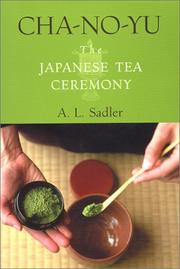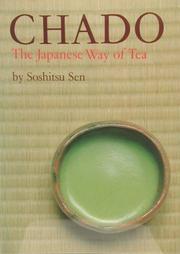| Listing 1 - 10 of 137 | << page >> |
Sort by
|
Book
ISBN: 1283032503 9786613032508 1448836131 Year: 2007 Publisher: New York, New York : Rosen Classroom Books & Materials,
Abstract | Keywords | Export | Availability | Bookmark
 Loading...
Loading...Choose an application
- Reference Manager
- EndNote
- RefWorks (Direct export to RefWorks)
Book
ISBN: 0870112074 Year: 1973 Publisher: Tokyo ; New York : Kodansha International; [distributed in the U.S. by Harper & Row, New York,
Abstract | Keywords | Export | Availability | Bookmark
 Loading...
Loading...Choose an application
- Reference Manager
- EndNote
- RefWorks (Direct export to RefWorks)
Book
Year: 1950 Publisher: Frankfurt am Main : Insel,
Abstract | Keywords | Export | Availability | Bookmark
 Loading...
Loading...Choose an application
- Reference Manager
- EndNote
- RefWorks (Direct export to RefWorks)
Book
ISBN: 9780141191843 0141191848 Year: 2010 Publisher: London : Penguin,
Abstract | Keywords | Export | Availability | Bookmark
 Loading...
Loading...Choose an application
- Reference Manager
- EndNote
- RefWorks (Direct export to RefWorks)

ISBN: 0804834075 1462901913 Year: 1998 Publisher: Rutland, Vt. : Charles E. Tuttle Co.,
Abstract | Keywords | Export | Availability | Bookmark
 Loading...
Loading...Choose an application
- Reference Manager
- EndNote
- RefWorks (Direct export to RefWorks)
This disciplined estheticism, as expressed in architecture, garden design, flower arrangement, pottery, painting, and other arts intimately related with the cha-no-yu, forms the focus of attention in the first part of this book.The second part, entitled ""Tea Masters, "" presents a series of stories illustrating the tea experiences of representative men of all types during the Muromachi, Momoyama, and Tokugawa periods. The book is abundantly illustrated with drawings of tea-ceremony furniture and utensils, tearoom architecture and garden design, floor and ground plans, and numerous other
Book
Year: 2018 Publisher: Honolulu : University of Hawaiʻi Press,
Abstract | Keywords | Export | Availability | Bookmark
 Loading...
Loading...Choose an application
- Reference Manager
- EndNote
- RefWorks (Direct export to RefWorks)
The overwhelming majority of tea practitioners in contemporary Japan are women, but there has been little discussion on their historical role in tea culture (chanoyu). In Cultivating Femininity, Rebecca Corbett writes women back into this history and shows how tea practice for women was understood, articulated, and promoted in the Edo (1603-1868) and Meiji (1868-1912) periods. Viewing chanoyu from the lens of feminist and gender theory, she sheds new light on tea's undeniable influence on the formation of modern understandings of femininity in Japan. Cultivating Femininity offers a new perspective on the prevalence of tea practice among women in modern Japan. It presents a fresh, much-needed approach, one that will be appreciated by students and scholars of Japanese history, gender, and culture, as well as by tea practitioners.

ISBN: 0824820878 Year: 1998 Publisher: Honolulu University of Hawaii Press
Abstract | Keywords | Export | Availability | Bookmark
 Loading...
Loading...Choose an application
- Reference Manager
- EndNote
- RefWorks (Direct export to RefWorks)

ISBN: 0834815184 Year: 1979 Publisher: Kyoto Tankosha
Abstract | Keywords | Export | Availability | Bookmark
 Loading...
Loading...Choose an application
- Reference Manager
- EndNote
- RefWorks (Direct export to RefWorks)
Book
Year: 2018 Publisher: Honolulu : University of Hawaiʻi Press,
Abstract | Keywords | Export | Availability | Bookmark
 Loading...
Loading...Choose an application
- Reference Manager
- EndNote
- RefWorks (Direct export to RefWorks)
The overwhelming majority of tea practitioners in contemporary Japan are women, but there has been little discussion on their historical role in tea culture (chanoyu). In Cultivating Femininity, Rebecca Corbett writes women back into this history and shows how tea practice for women was understood, articulated, and promoted in the Edo (1603-1868) and Meiji (1868-1912) periods. Viewing chanoyu from the lens of feminist and gender theory, she sheds new light on tea's undeniable influence on the formation of modern understandings of femininity in Japan. Cultivating Femininity offers a new perspective on the prevalence of tea practice among women in modern Japan. It presents a fresh, much-needed approach, one that will be appreciated by students and scholars of Japanese history, gender, and culture, as well as by tea practitioners.
Book
ISBN: 0870119419 Year: 1989 Publisher: New York Kodansha international
Abstract | Keywords | Export | Availability | Bookmark
 Loading...
Loading...Choose an application
- Reference Manager
- EndNote
- RefWorks (Direct export to RefWorks)
| Listing 1 - 10 of 137 | << page >> |
Sort by
|

 Search
Search Feedback
Feedback About UniCat
About UniCat  Help
Help News
News